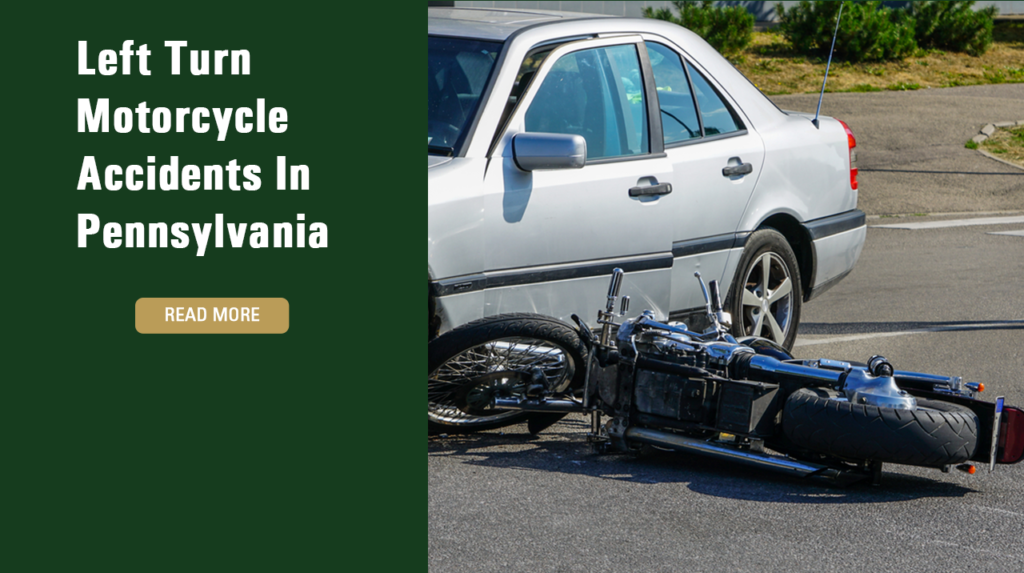Left Turn Motorcycle Accident In Pennsylvania

Motorcycle crashes frequently result in serious injuries or fatalities. People traveling on motorcycles have a much higher risk of being killed or seriously injured per vehicle mile traveled than passenger vehicle occupants. Among the various types of motorcycle crashes that occur, motorcycle crashes involving a left-turning vehicle are the most frequently occurring two-vehicle motorcycle collisions. According to the National Highway Traffic Safety Administration, 5,014 motorcyclists were killed in motorcycle crashes in 2019 alone. Out of those who died, 1,034 involved a left-turning vehicle, or 41% of all fatal crashes involving two vehicles. Understanding left-turn accidents, their causes, and how to avoid them is critical for motorcyclists. People who are seriously injured in left-turn motorcycle accidents or their loved ones should consult a motorcycle accident attorney at Raynes & Lawn.
What Is A Left Turn Accident?
Left turn motorcycle crashes occur when a passing or oncoming motorcycle is struck by a left-turning vehicle. These types of collisions happen in three different ways. The most common type of left-turn motorcycle collision occurs when a vehicle turns left and strikes a motorcycle traveling through an intersection. Another way a left-turn motorcycle crash can happen occurs when a motorcycle is waiting at an adjacent corner and is struck by a vehicle turning left onto that street. Left-turn motorcycle collisions also sometimes occur when a motorist doesn’t obey a stop sign while turning at an intersection and strikes a motorcycle that is crossing through it.
How Do Left Turn Motorcycle Accidents Happen?
Left-turn motorcycle crashes can be caused by several problems. In many crashes, the left-turning motorist fails to check a corner or intersection before turning left and strikes a motorcyclist. This sometimes happens when a motorist is preparing to turn left onto a major road from a side street and fails to adequately check oncoming traffic before pulling out and striking a motorcyclist who was traveling straight.
Poor visibility can also cause left-turn motorcycle crashes. In this type of scenario, the motorist will not see a crossing or oncoming motorcyclist until it is too late because of blind spots, road obstructions, or weather conditions.
Driver distraction sometimes results in left-turn accidents with motorcyclists. If the motorist is distracted by something inside or outside of his or her vehicle, he or she might fail to notice the motorcycle until right before the collision.
Speeding motorists also can cause motorcycle crashes when the vehicles are turning left. For example, a speeding motorist who is trying to make a light before it turns red but ends up turning on a red light might strike a motorcyclist who is traveling through.
Finally, driving while impaired can result in left-turn motorcycle collisions. Impaired drivers exhibit reduced vigilance while they drive and often have a lower awareness of their surroundings. They also might forget to use their turn signals before initiating turns.
Liability And Exceptions
In most left-turn motorcycle crashes, the motor vehicle driver will be at fault. However, there are certain exceptions to this general rule. At an intersection with a stoplight, the vehicle or motorcycle that has a green light will have the right-of-way. At 4-way intersections without traffic control devices, the vehicle that is going straight will have the right of way. At T-intersection, the left-turning vehicle must yield to all oncoming traffic before initiating the turn. There are a few different scenarios in which the motorcyclist might share some of the faults for a left-turn motorcycle crash.
Some of these exceptions include the following:
- Motorcyclist running a red light
- Speeding through an intersection
- Motorcyclist strikes a vehicle that was more than halfway through its left turn
- Vehicle stalling while turning, and the motorcyclist hits the stalled vehicle
In these types of situations, the left-turning vehicle driver’s liability might be reduced by the percentage of fault held by the motorcyclist.
How To Avoid Left Turn Motorcycle Accidents
Since left-turn motorcycle crashes are normally the fault of the motorist, you should do the following things to reduce your chances of being struck by a left-turning vehicle while riding on your motorcycle:
- Wear bright, highly visible clothing and gear.
- Choose riding gear with a reflective design.
- Don’t wear dark gear in periods of low visibility or reduced daylight.
- Approach all intersections with caution.
- Slow down as you approach intersections even if they appear to be clear of traffic.
- Look both ways even when you have the right of way.
- Be proactive instead of reactive.
Watch ahead of you on the road while you are riding on your motorcycle. If you see a vehicle on a side street or at an intersection that is preparing to turn left, try to anticipate the motorist’s move. Don’t rely on a driver’s turn signal since some motorists fail to use them. Instead, watch for other signs, including a motorist slowing down to try to take a turn, the direction of the vehicle’s wheels, or the driver turning his or her head. When you do stop at an intersection, make sure that you leave plenty of space for motorists that might be turning. Make sure that you observe your motorcycle’s stopping distance to avoid left-turning vehicles, and plan a trajectory you can swerve if you cannot brake on time to avoid a turning car.
When To Contact A Motorcycle Accident Injury Lawyer
If you are seriously injured in an accident with a left-turning vehicle or have lost your loved one in this type of collision, you should speak to an experienced motorcycle accident attorney at Raynes & Lawn as soon as possible. If you wait too long, your ability to pursue compensation could be time-barred by the statute of limitations. It is also a good idea to retain a lawyer soon after your collision so that he or she can gather and preserve evidence that might otherwise be lost as time passes. Contact us today to schedule a free consultation by calling 1-800-535-1797.

For the general public: This Blog/Website is made available by the law firm publisher, Raynes & Lawn, for educational purposes. It provides general information and a general understanding of the law but does not provide specific legal advice. By using this site, commenting on posts, or sending inquiries through the site or contact email, you confirm that there is no attorney-client relationship between you and the Blog/Website publisher. The Blog/Website should not be used as a substitute for competent legal advice from a licensed attorney in your jurisdiction.
For attorneys: This Blog/Website is informational in nature and is not a substitute for legal research or a consultation on specific matters pertaining to your clients. Due to the dynamic nature of legal doctrines, what might be accurate one day may be inaccurate the next. As such, the contents of this blog must not be relied upon as a basis for arguments to a court or for your advice to clients without, again, further research or a consultation with our professionals.

